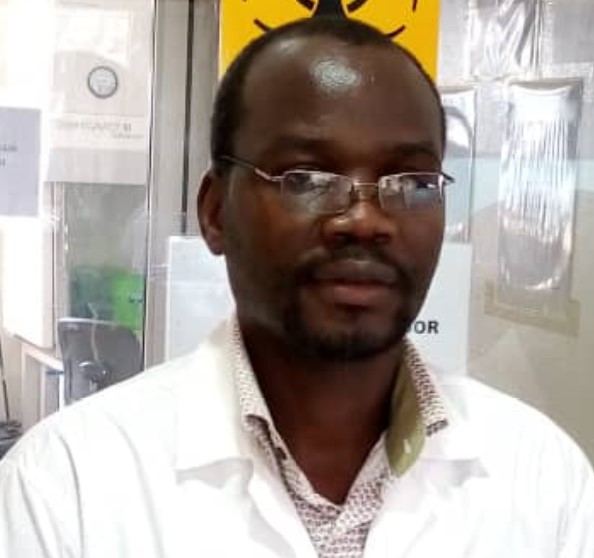
Dr
Charissa Naidoo
Current Organisation
Stellenbosch University
Current Job Title
Lecturer
Biography
Publications
While the acquisition of drug resistance is often accompanied by fitness costs, Mycobacterium tuberculosis has developed mechanisms to overcome these costs in the form of compensatory mutations. In an attempt to dissect strain-specific differences in biological fitness, 10 M. tuberculosis genomes, representing F15/LAM4/KZN, Beijing, F11 and F28 genotypes were sequenced on the Illumina MiSeq platform. Drug-susceptible F15/LAM4/KZN strains differed by 43 SNPs, demonstrating that heterogeneity exists even among closely-related strains. We found unique, nonsynonymous single-nucleotide polymorphisms (SNPs) in the sigA and grcC1 genes of multidrug resistant (MDR) and XDR F15/LAM4/KZN strains, respectively. The F28 MDR strain harboured a novel ubiA mutation in combination with its embB M306I mutation, which may be related to ethambutol resistance. In addition, it possessed a low-frequency rpoC mutation, suggesting that this strain was in the process of developing compensation. In contrast, no compensatory mutations were identified in Beijing and F11 MDR strains, corroborating its low in vitro fitness. Clinical strains also harboured unique SNPs in a number of important genes associated with virulence, highlighting the need for future studies which examine the correlation of genetic variations with phenotypic diversity. In summary, whole-genome sequencing revealed the presence of fitness-compensatory mutations in F15/LAM4/KZN and F28 genotypes which predominate in MDR and/or extensively drug resistant (XDR) forms in KwaZulu-Natal, South Africa.
The role of fitness in transmission of drug-resistant strains has been explored in previous studies; but has not been established for F15/LAM4/KZN strains, which were responsible for the extensively drug-resistant tuberculosis (XDR-TB) outbreak in Tugela Ferry, South Africa. The biological fitness of 15 clinical strains representing the F15/LAM4/KZN, Beijing, F11 and F28 families was determined by growth, viability and competition assays and correlated with DNA sequencing of eight genes associated with drug resistance and putative compensatory mechanisms. Similar growth rates were observed among susceptible, multidrug-resistant (MDR) and XDR strains of the KZN and F28 genotypes. In contrast, Beijing and F11 MDR strains demonstrated significantly reduced fitness. Resistant strains exhibited heterogeneous fitness profiles in competition with different susceptible strains, suggesting strain dependence. In addition, co-culture growth rates were consistently higher than independent growth rates in 13/14 competition pairs. All 14 drug-resistant strains retained viability, at a low CFU/mL, when paired with susceptible strains. The persistence of such resistant strains could consequently support the acquisition of additional drug-resistance-conferring mutations and/or the evolution of compensatory mechanisms. Frequently occurring mutations were detected in KZN and F28 resistant strains whereas, the Beijing MDR strain harboured a less common katG mutation and the F11 MDR strain had no katG mutation. Contrary to drug-resistant Beijing and F11 strains, the successful transmission of KZN strains, particularly during the outbreak, may be attributed to the presence of drug-resistance-conferring mutations associated with little or no associated fitness costs. Amplified growth in co-culture may be suggestive of in vivo trans-complementation.
Background: Xpert MTB/RIF Ultra (Ultra) is a new test for tuberculosis undergoing global roll-out. We assessed the performance of Ultra compared with Xpert MTB/RIF (Xpert) in an HIV-endemic setting where previous tuberculosis is frequent and current test performance is suboptimal.
Methods: In this two-cohort diagnostic accuracy study, we used sputum samples from patients in South Africa to evaluate the accuracy of Ultra and Xpert against a single culture reference standard. For the first cohort (cohort A), we recruited adults (aged ≥18 years) with symptoms of presumptive tuberculosis at Scottsdene clinic in Cape Town, South Africa. We collected three sputum samples from each patient in cohort A, two at the first visit of which one was tested using Xpert and the other was tested using culture, and one sample the next morning which was tested using Ultra. In a separate cohort of patients with presumptive tuberculosis and recent previous tuberculosis (≤2 years) who had submitted sputum samples to the National Health Laboratory Services (cohort B), decontaminated sediments were, after processing, randomly allocated (1:1) for testing with Ultra or Xpert. For both cohorts we calculated the sensitivity and specificity of Ultra and Xpert and evaluated the effects of different methods of interpreting Ultra trace results.
Findings: Between Feb 6, 2016, and Feb 2, 2018, we recruited 302 people into cohort A, all of whom provided sputum samples and 239 were included in the head-to-head analyses of Ultra and Xpert. For cohort B, we collected sputum samples from eligible patients who had submitted samples between Dec 6, 2016, and Dec 21, 2017, to give a cohort of 831 samples, of which 352 were eligible for inclusion in analyses and randomly assigned to Ultra (n=173) or Xpert (n=179). In cohort A, Ultra gave more non-actionable results (not positive or negative) than did Xpert (28 [10%] 275 vs 14 [5%] 301; p=0·011). In the head-to-head analysis, in smear-negative patients, sensitivity of Ultra was 80% (95% CI 64–90) and of Xpert was 73% (57–85; p=0·45). Overall, specificity of Ultra was lower than that of Xpert (90% [84–94] vs 99% [95–100]; p=0·001). In cohort B, overall sensitivity was 92% (81–98) for Xpert versus 86% (73–95; p=0·36) for Ultra and overall specificity was 69% (60–77) for Ultra versus 84% (78–91; p=0·005) for Xpert. Ultra specificity estimates improved after reclassification of results with the lowest Ultra-positive semiquantitation category (trace) to negative (15% [8–22]). In cohort A, the positive predictive value (PPV) for Ultra was 78% (67–87) and for Xpert was 96% (87–99; p=0·004); in cohort B, the PPV for Ultra was 50% (43–57) and for Xpert was 70% (61–78; p=0·014). Ultra PPV estimates in previously treated patients were low: at 15% tuberculosis prevalence, half of Ultra-positive patients with presumptive tuberculosis would be culture negative, increasing to approximately 70% in patients with recent previous tuberculosis. In cohort B, 21 (28%) of 76 samples that were Ultra positive were rifampicin indeterminate (all trace) and, like cohort A, most were culture negative (19 [90%] of 21).
Interpretation: In a setting with a high burden of previous tuberculosis, Ultra generated more non-actionable results and had diminished specificity compared with Xpert. In patients with recent previous tuberculosis, a quarter of Ultra-positive samples were indeterminate for rifampicin resistance and culture negative, suggesting that additional drug-resistance testing will probably be unsuccessful. Our data have implications for the handling of Ultra-positive results in patients with previous tuberculosis in high burden settings.
The diverse microbial communities within our bodies produce metabolites that modulate host immune responses. Even the microbiome at distal sites has an important function in respiratory health. However, the clinical importance of the microbiome in tuberculosis, the biggest infectious cause of death worldwide, is only starting to be understood. Here, we critically review research on the microbiome’s association with pulmonary tuberculosis. The research indicates five main points: (1) susceptibility to infection and progression to active tuberculosis is altered by gut Helicobacter co-infection, (2) aerosol Mycobacterium tuberculosis infection changes the gut microbiota, (3) oral anaerobes in the lung make metabolites that decrease pulmonary immunity and predict progression, (4) the increased susceptibility to reinfection of patients who have previously been treated for tuberculosis is likely due to the depletion of T-cell epitopes on commensal gut non-tuberculosis mycobacteria, and (5) the prolonged antibiotic treatment required for cure of tuberculosis has long-term detrimental effects on the microbiome. We highlight knowledge gaps, considerations for addressing these knowledge gaps, and describe potential targets for modifying the microbiome to control tuberculosis.
Aspiration is associated with nontuberculous mycobacterial (NTM) pulmonary disease and airway dysbiosis is associated with increased inflammation. We examined whether NTM disease was associated with a distinct airway microbiota and immune profile. 297 oral wash and induced sputum samples were collected from 106 participants with respiratory symptoms and imaging abnormalities compatible with NTM. Lower airway samples were obtained in 20 participants undergoing bronchoscopy. 16S rRNA gene and nested mycobacteriome sequencing approaches characterised microbiota composition. In addition, inflammatory profiles of lower airway samples were examined. The prevalence of NTM+ cultures was 58%. Few changes were noted in microbiota characteristics or composition in oral wash and sputum samples among groups. Among NTM+ samples, 27% of the lower airway samples were enriched with Mycobacterium. A mycobacteriome approach identified Mycobacterium in a greater percentage of samples, including some nonpathogenic strains. In NTM+ lower airway samples, taxa identified as oral commensals were associated with increased inflammatory biomarkers. The 16S rRNA gene sequencing approach is not sensitive in identifying NTM among airway samples that are culture-positive. However, associations between lower airway inflammation and microbiota signatures suggest a potential role for these microbes in the inflammatory process in NTM disease.
Project Title
The longitudinal microbiome of South African tuberculosis patients, symptomatic culture-negative controls and healthy household contacts, and its association with treatment outcome (MOSAIC)
EDCTP Project
TMA2017CDF-1914
EDCTP Program
EDCTP2
EDCTP Project Call
Career Development Fellowship (CDF)
Host Organisation
| Department | Institution | Country |
|---|---|---|
| Biomedical Sciences | Stellenbosch University | ZA |
Project Objectives
In MOSAIC (Microbiome of South African Incident TB Cases; https://bit.ly/3cT8GC5), we sought to describe the gut microbiome of cases pre-treatment (versus matched symptomatic controls and healthy household contacts), during treatment (months 2 and 6) and post-treatment (months 12 and 18) (later two comparisons made with healthy household contacts only). We also aimed to develop local analytical capacity and assemble a specialised biobank for follow-up evaluations where the microbiome may be targeted for one of the biggest global infectious lung diseases.
Study Design
Observational
Project Summary
The microbiome is a critical mediator of health and may play a role at each stage of the tuberculosis (TB) spectrum. The MOSAIC study (https://bit.ly/3cT8GC5) is investigating the role of the gut microbiome in TB patients from Cape Town, South Africa before, during, and one year after treatment, with the goal of identifying microbiome-based diagnostic or therapeutic targets. The project also seeks to develop local capacity in cutting edge computational methods and the creation of a high-quality specimen- and sequence data biobank for future innovative research on the microbiome and TB. We have shown that, compared to symptomatic controls, cases have a gut microbiome enriched in anaerobes (Anaerostipes, Blautia, Erysipelotrichaceae) and precursor inferred pathways (amino acid and carbohydrate metabolic pathways) of short chain fatty acids. Enriched anaerobes in cases correlate with several proinflammatory immune pathways associated with TB disease severity. In contrast, enriched taxa identified in controls did not correlate with immune pathways, suggesting that these microbe-host pathways are specific to TB. Although the microbiome is modifiable by antibiotics, little is known on the effects of first-line TB treatment. Preliminary findings from 75 cases on treatment reveal TB antibiotics significantly deplete microbial diversity and composition during the first two months. These effects persist at the end of treatment and up to one year later, indicating poor reconstitution of the gut microbiota. In contrast, culture-negative household contacts maintain a stable gut microbiome over the 18-month sampling period. We are using longitudinal clustering methods to determine linkages between the gut microbiome (diversity, specific taxa) and treatment outcomes. The MOSAIC research team is, in addition to the PI (Dr Charissa Naidoo), comprised of Drs Grant Theron, Robin Warren and Gerhard Walzl (Stellenbosch University), and Leopoldo Segal and Benjamin Wu (New York University). Two students (Ms Georgina Nyawo and Mr Tinaye Chiyaka) are also being trained in microbiome methods, thereby building computational capacity in Africa. Intensified exploration of the microbiome’s role in TB disease, side effects during treatment, and outcomes (including post-TB sequelae) is likely to have a socio-economic impact as it may lead to the development of novel prognostic markers and therapeutics (prebiotics, probiotics, and host-directed therapies) for TB.


